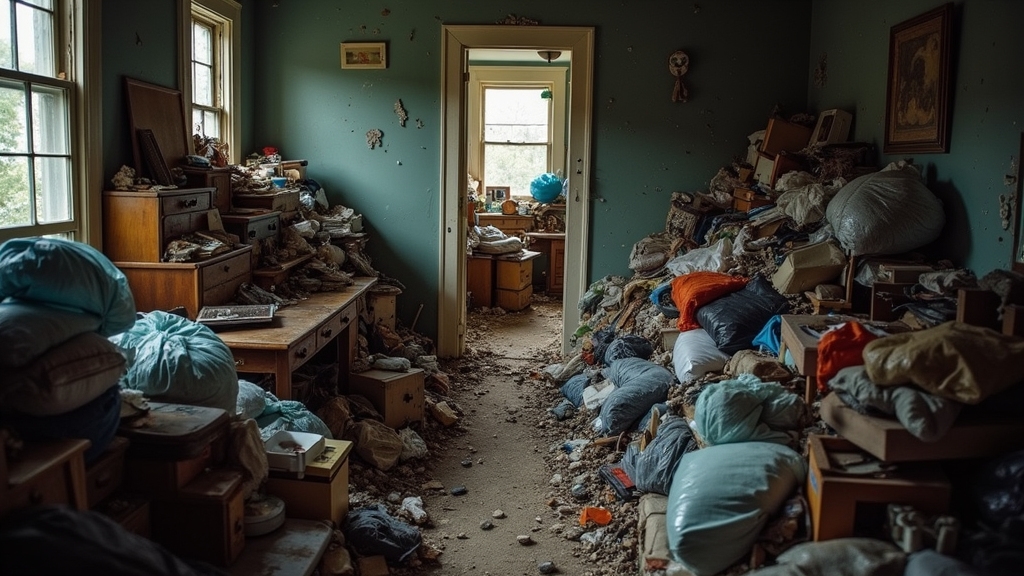Trying to sell a hoarder house can feel overwhelming. Hoarding affects up to 6% of homes in the U.S., causing major drops in value and appeal. Many sellers find it hard to get buyers interested in these properties.
The problems go beyond clutter. Safety risks, legal issues, and strong emotions often block a smooth sale. These challenges can make the entire process stressful and confusing.
You can overcome the challenges of selling a hoarder house with the right steps and strategies. Simple actions like a thorough cleanout and targeted marketing help.
The right approach can turn a problem property into a valuable asset. This blog will guide you through each step to make selling a hoarder house easier and more successful.
Key Takeaways
- Hoarding significantly lowers property value and raises safety, health, and legal concerns that deter buyers.
- Structural damage and hidden repairs must be identified and addressed to meet buyer and lender requirements.
- Decluttering and deep cleaning with professional help can improve appeal and reduce stigma for potential buyers.
- Resolving permits, liens, and legal issues early prevents delays and legal complications during the sale process.
- Transparent disclosures, strategic marketing, and focusing on fixer-upper buyers help attract offers and speed up closing.
Understanding the Scope of Hoarding and Its Impact on Property Value

A home affected by hoarding usually loses value. Clutter, neglect, and health risks make the property less appealing to buyers. Buyers often avoid homes that need a lot of work to fix.
Hoarding makes repairs and cleaning difficult. Emotional ties to items can delay clearing out and routine maintenance. Family disagreements over what to keep or throw away may also slow progress.
If you want to protect your property’s value, address hoarding issues early. You should consider hiring professionals who understand hoarding behavior. They can help resolve family conflicts and guide cleanup efforts, making your property more attractive.
Additionally, understanding the steps in selling a home for cash to avoid probate can help expedite the sale process and reduce stress during this challenging time. Recognizing hoarding disorder as a mental health condition is crucial for developing effective strategies to manage the clutter and improve the home’s condition.
Identifying Safety and Health Hazards
You’ll need to identify hazardous materials like mold, biohazards, and flammable items that often accumulate in hoarder homes. Assess the property’s structural integrity carefully, as excessive clutter can hide water damage, pest infestations, or weakened floors. Prioritizing a thorough inspection lets you address these risks early and protect both buyers and workers.
Conducting a title search can also uncover any legal issues or encumbrances that might complicate the sale or occupancy process. Additionally, understanding the home’s market value is crucial for setting realistic expectations and ensuring a fair transaction.
Common Hazardous Materials Found
Hoarder houses often contain many hazardous materials. These materials can cause serious health and safety risks if disturbed. Common dangers include old cleaning supplies, chemicals, and biological waste.
Leaking chemicals may create toxic fumes or contaminate surfaces. Lead paint is often found in homes built before 1978. If you disturb these painted surfaces, lead dust could become a danger.
Mold and asbestos are also frequent hazards in hoarder houses. These can hide under clutter or inside neglected rooms. If you suspect these risks, hire professionals for safe removal.
You should never try to clean up hazardous waste or lead paint by yourself. Proper removal requires special training and equipment. Professional help ensures safety and compliance with laws.
Assessing Structural Integrity
Assessing structural integrity means checking if the house is safe and stable. Hoarder homes may have hidden damage that affects safety. Heavy piles can stress floors and weaken the foundation.
Moisture from leaks or bad ventilation can cause rot and mold. This moisture may also damage wood supports. Pest infestations can further harm the structure if left untreated.
A qualified inspector should check joists, beams, and the foundation. If issues are found, repairs should be prioritized. A full assessment helps you share information with buyers and avoid future problems.
If you invest in a detailed inspection, you can protect everyone’s safety. Proper repairs and honest disclosure will help you get the best value for the home.
Addressing Structural Damage and Required Repairs

Structural damage and needed repairs can make selling a hoarder house difficult. These issues lower the home’s value and may create safety risks. If you want to sell, you must address these problems.
A full home inspection can reveal hidden damage like weak floors, bad wiring, or mold. Safety-related repairs should be completed first, as buyers and banks often require them. You should keep records of all repairs and damage.
If you plan to file insurance claims, proper documentation will help your case. Getting several repair estimates can save money and time. If you fix issues and share details with buyers, you may sell the house more smoothly.
Additionally, understanding the termite threat and addressing any infestations can prevent further damage that could complicate the sale. Regular inspections and preventative measures are essential to managing structural integrity and avoiding unexpected costs later on.
Managing Emotional Attachments and Family Dynamics
Emotional attachments and family dynamics can be as difficult as cleaning a hoarder house. These feelings often make it hard to decide what to keep or throw away. Family disagreements may also happen if people have different opinions about the items. Open and honest communication helps reduce misunderstandings.
Setting clear rules early can prevent arguments before they start. If problems continue, a neutral third party like a counselor may help. Addressing emotions directly leads to better decisions. A simple, structured plan can guide everyone through the process.
This approach helps lower stress and keeps things moving forward. Reviewing public records can also provide clarity about property ownership and reduce conflicts. Understanding financial aspects such as liens or ownership history can further streamline the decision-making process and prevent surprises.
Navigating Legal and Regulatory Issues

You’ll need to address strict disclosure requirements, making sure buyers understand the property’s true condition. Check that the house meets local zoning and code regulations, as violations can block or delay a sale. Research all permits and liens early so you can resolve issues before they become deal-breakers.
Additionally, understanding neighborhood comps helps ensure that the property’s valuation aligns with recent sales, avoiding potential appraisal issues. Being aware of the sales contract terms and ensuring proper documentation can also prevent legal complications later on.
Disclosure Requirements Explained
You must fully disclose a property’s hoarding history to ensure a smooth sale. Law requires you to share any issues affecting value or appeal. Hoarding may cause hidden problems like mold, pests, or damage.
If you hide these issues, buyers can sue or cancel the sale. Documentation of repairs and inspection reports helps protect you. Always ask your real estate agent about local disclosure rules.
Use detailed disclosure forms for accuracy. Being honest builds trust and lowers your risk. Transparency helps make the sale process easier and more successful.
Zoning and Code Compliance
Zoning and code compliance are important when selling a hoarder house. Zoning laws control how you can use a property. If a house has too much clutter or added structures, it may break these rules.
You should check your local zoning ordinances before listing the house. Building codes also matter, as hoarder homes can have problems like unsafe wiring or blocked exits. If there are violations, the sale could be delayed or stopped.
A professional inspection can help find safety issues early. If you fix these problems first, the selling process will be easier. Buyers will also feel more confident about the home’s safety and legal status.
Permits and Liens Research
Unresolved permits and property liens can make selling a hoarder house difficult. Permits show that renovations have city approval and meet codes. If permits are missing or expired, the sale may be delayed or canceled.
A lien is a legal claim against the property for unpaid debts. Common liens include unpaid taxes, contractor bills, or utility fees. These liens must be paid off before the home can be sold.
You can check for liens at your local county recorder’s office. A title company can also help you find any hidden liens. If you resolve these issues early, you can make the selling process smoother and avoid legal problems.
Dealing With Stigmatization and Buyer Perceptions
Stigmatization and negative buyer perceptions are common challenges when selling a hoarder house. Buyers often worry about health risks, hidden damage, and high repair costs. You must address these concerns directly to build trust. Acknowledging that cosmetic flaws are superficial and can be easily fixed may help ease buyer anxiety.
Clear communication helps change how buyers see the property. Share inspection reports and highlight any improvements made. If you provide before-and-after photos, buyers can better understand the progress. Transparency is key to managing stigma. You should disclose all remediation steps and set realistic expectations. Emphasize positive features of the neighborhood to counter negative assumptions.
Developing a Decluttering and Cleaning Plan
Start by thoroughly assessing the level of hoarding to understand the scope of work needed. You’ll need to prioritize cleanup areas that have the greatest impact on safety, access, and buyer impressions. This strategic approach lets you allocate resources efficiently and tackle the most critical zones first.
Incorporating a deceased estate transfer process can also streamline the legal steps involved in property sale. Additionally, understanding the distinction between marital and separate property can help in managing inherited items or assets that may be part of the estate.
Assessing Hoard Level
To assess a hoard level, start by checking how much clutter is in the house. Walk through each room and note any blocked doors or dangerous areas. If you skip this step, you may underestimate how much work is needed.
Use a tool like the Clutter Image Rating to measure the severity. This rating helps you decide if professional help is needed. An accurate assessment will help you plan for cleaning and repairs.
If you understand the situation, you can set clear goals. Proper assessment also helps you explain the plan to cleaners, agents, or buyers. Always base your next steps on this first evaluation.
Prioritizing Cleanup Areas
Start by choosing the most important areas to clean first. Entryways, hallways, and exits must be clear for safe movement. Kitchens and bathrooms come next because they are vital for health.
Focus on rooms that make the home more livable and attractive to buyers. If you want quick results, clean one area at a time. Organizing clutter is easier when you sort items into keep, donate, discard, or sell categories.
Use a step-by-step plan, and do not try to do everything at once. Set small goals and track your progress. If you become attached to items, remember that clearing clutter helps the property sell.
Finding the Right Professionals to Assist With Cleanup
Qualified cleanup professionals make the process safer and faster. They have experience handling hoarding situations and know how to manage them. If you choose experts, you reduce stress and risk. Additionally, professionals who are familiar with effective pricing strategies can help assess the property’s value accurately, ensuring you set a competitive price that attracts cash buyers.
Look for companies that offer discreet service and emotional support. Professionals who understand the situation can work with sensitivity and respect. Some teams also help prepare the home for sale. Always check credentials, insurance, and reviews before hiring anyone. Reliable companies clearly explain their sorting and disposal methods. If they communicate well, your cleanup will go smoothly.
Estimating Cleanup and Repair Costs
Estimating cleanup and repair costs starts with checking the whole house. Look for clutter, damage, or signs of mold and pests. You need to know what needs fixing before making any decisions.
Take photos and notes of all problem areas during your walkthrough. If you see water damage or structural problems, write them down. This helps you remember what needs attention.
Get quotes from cleanup companies and contractors. Professionals can find hidden damage you might miss. Compare several quotes to get a fair price.
Check your insurance policy for possible coverage. Some cleanup or repair costs may be included. If covered, you could save money.
Include all estimates in your property value calculation. High repair costs or ignored issues can lower your home’s value. Stay organized to avoid surprises and make better decisions.
Additionally, consider unrealistic pricing pitfalls, as overestimating your property’s value can lead to extended time on market or financial loss if the house is overpriced.
Deciding Between As-Is Sales and Renovations
You need to weigh the immediate savings of selling as-is against the possible return on investment from renovations. Consider how each option affects your timeline and the size of your buyer pool—renovated homes attract more traditional buyers, while as-is sales often appeal to investors. By analyzing your resources and goals, you’ll identify the strategy that maximizes your outcome.
Weighing Time Versus Cost
When selling a hoarder house, you must weigh time against possible profit. Renovating takes longer but can bring a higher sale price. Selling as-is is much faster but usually means a lower offer.
Renovation needs money and months of work. You might need to pay for cleaning, repairs, and contractors. If you do not have much time, selling as-is is a good choice.
If you want the most money, add up renovation costs and expected profit. Consider how much your time is worth. This helps you decide if speed or a higher return is better for you.
Impact on Buyer Pool
The condition of a hoarder house greatly reduces the number of interested buyers. Most regular buyers avoid these homes due to cleanup and repair worries. Only investors or cash buyers usually consider purchasing such properties.
Selling as-is limits your options and often leads to lower offers. Many buyers think hoarder houses are too risky or costly to fix. This negative perception keeps most traditional buyers away.
Renovating the home can attract more buyers. Fixing visible problems and cleaning up improves the home’s image. If you invest in repairs, you may get higher offers and a bigger buyer pool.
You should compare the costs of renovations with the possible increase in value. The choice between selling as-is or renovating affects both buyer interest and final sale price. Always consider your budget and timeline before deciding.
Marketing Strategies for Difficult Properties
Selling a hoarder house is challenging, but smart marketing can attract the right buyers. Focus on the property’s investment potential and reach buyers who want fixer-uppers. Highlight key features like location and lot size if they are strong points.
Digital marketing platforms help increase your listing’s visibility among investors and cash buyers. Social media groups for real estate investments are good places to promote the property. If you use these channels, the property will reach buyers who are searching for projects.
Listing descriptions should be honest about the home’s condition. You can emphasize positive aspects, like redevelopment opportunities. Including virtual staging or before-and-after pictures helps buyers see the home’s potential.
If you combine these strategies, your property can stand out in the market. Each step aims to match the right buyer with your property. This approach helps maximize the property’s value even if it has challenges.
Disclosures and Ethical Considerations
When selling a hoarder house, you must give clear and honest disclosures. Buyers need to know about all defects and health risks. Full disclosure protects you from legal problems.
You should list any structural damage or safety hazards. If personal items remain, respect the privacy of the previous owner. Secure agreements to protect their dignity and private information.
Emotional factors may also affect the sale. If the house has strong emotional ties, mention this to all parties. Addressing these issues early helps build trust.
Always consult a real estate attorney before listing. An attorney can check that your disclosures follow local laws. This step gives you legal and ethical protection.
Negotiating With Investors and Cash Buyers
Negotiating with investors and cash buyers is different from selling to regular homebuyers. Investors care most about price, speed, and reducing risk. You need clear strategies to get the best deal. Selling to investors means focusing on price, speed, and risk. Use smart negotiation to secure the best deal possible.
Investors often offer less than market value because they consider repair and clean-up costs. If you know your property’s strengths, you can still get a fair price. Highlight anything special about your property.
You should decide your lowest acceptable price before talks begin. If you stay firm and clear, you can avoid pressure. Sellers who know their limits negotiate better.
If you can offer investors fast closings or a good location, mention these early. Investors value deals without delays or extra conditions. Pointing out these benefits can help you get a better offer.
Requesting proof of funds from buyers is important. This step shows you are serious and protects your interests. If buyers cannot show funds, consider moving on.
Streamlining the Closing Process
Streamlining the closing process means making the sale finish smoothly and quickly. You should gather all important documents, like the title and inspection reports, before closing. Keeping paperwork ready helps prevent last-minute problems.
If the house still has belongings, hire a cleanout crew or use storage services. This step meets buyer needs and reduces your stress. Clear spaces also make the final walk-through easier.
You must stay in touch with the buyer and title company. Confirm dates, needed signatures, and payment details in advance. Quick communication helps avoid delays.
If you expect any obstacles, handle them as soon as possible. A well-planned approach keeps the closing on schedule. This way, you finish the sale with less hassle.
Conclusion
If you need to sell a hoarder house, you may face unique challenges. If you address safety, legal, and structural issues first, you can improve your chances. If you work with professionals, you can streamline the process and avoid costly mistakes.
If you want a fast and stress-free sale, you might consider selling to a company that buys houses for cash. If you choose this route, you can skip repairs, cleaning, and traditional showings. If you need to move quickly, this can be the best solution.
If you want to sell your hoarder house in Kansas City, we at Limitless Homes of KC can help. If you contact us, we can give you a fair cash offer and close on your schedule. If you are ready to sell, reach out to us today to get started.

